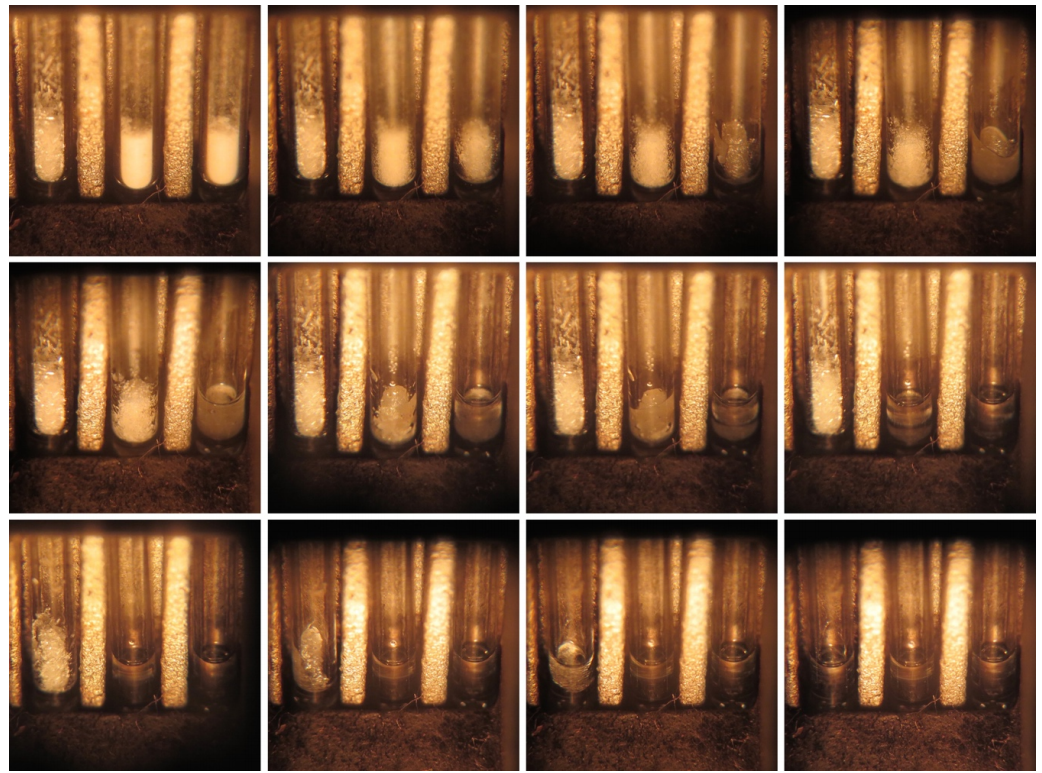6.1B: Uses of Melting Points
- Page ID
- 93432
\( \newcommand{\vecs}[1]{\overset { \scriptstyle \rightharpoonup} {\mathbf{#1}} } \)
\( \newcommand{\vecd}[1]{\overset{-\!-\!\rightharpoonup}{\vphantom{a}\smash {#1}}} \)
\( \newcommand{\id}{\mathrm{id}}\) \( \newcommand{\Span}{\mathrm{span}}\)
( \newcommand{\kernel}{\mathrm{null}\,}\) \( \newcommand{\range}{\mathrm{range}\,}\)
\( \newcommand{\RealPart}{\mathrm{Re}}\) \( \newcommand{\ImaginaryPart}{\mathrm{Im}}\)
\( \newcommand{\Argument}{\mathrm{Arg}}\) \( \newcommand{\norm}[1]{\| #1 \|}\)
\( \newcommand{\inner}[2]{\langle #1, #2 \rangle}\)
\( \newcommand{\Span}{\mathrm{span}}\)
\( \newcommand{\id}{\mathrm{id}}\)
\( \newcommand{\Span}{\mathrm{span}}\)
\( \newcommand{\kernel}{\mathrm{null}\,}\)
\( \newcommand{\range}{\mathrm{range}\,}\)
\( \newcommand{\RealPart}{\mathrm{Re}}\)
\( \newcommand{\ImaginaryPart}{\mathrm{Im}}\)
\( \newcommand{\Argument}{\mathrm{Arg}}\)
\( \newcommand{\norm}[1]{\| #1 \|}\)
\( \newcommand{\inner}[2]{\langle #1, #2 \rangle}\)
\( \newcommand{\Span}{\mathrm{span}}\) \( \newcommand{\AA}{\unicode[.8,0]{x212B}}\)
\( \newcommand{\vectorA}[1]{\vec{#1}} % arrow\)
\( \newcommand{\vectorAt}[1]{\vec{\text{#1}}} % arrow\)
\( \newcommand{\vectorB}[1]{\overset { \scriptstyle \rightharpoonup} {\mathbf{#1}} } \)
\( \newcommand{\vectorC}[1]{\textbf{#1}} \)
\( \newcommand{\vectorD}[1]{\overrightarrow{#1}} \)
\( \newcommand{\vectorDt}[1]{\overrightarrow{\text{#1}}} \)
\( \newcommand{\vectE}[1]{\overset{-\!-\!\rightharpoonup}{\vphantom{a}\smash{\mathbf {#1}}}} \)
\( \newcommand{\vecs}[1]{\overset { \scriptstyle \rightharpoonup} {\mathbf{#1}} } \)
\( \newcommand{\vecd}[1]{\overset{-\!-\!\rightharpoonup}{\vphantom{a}\smash {#1}}} \)
\(\newcommand{\avec}{\mathbf a}\) \(\newcommand{\bvec}{\mathbf b}\) \(\newcommand{\cvec}{\mathbf c}\) \(\newcommand{\dvec}{\mathbf d}\) \(\newcommand{\dtil}{\widetilde{\mathbf d}}\) \(\newcommand{\evec}{\mathbf e}\) \(\newcommand{\fvec}{\mathbf f}\) \(\newcommand{\nvec}{\mathbf n}\) \(\newcommand{\pvec}{\mathbf p}\) \(\newcommand{\qvec}{\mathbf q}\) \(\newcommand{\svec}{\mathbf s}\) \(\newcommand{\tvec}{\mathbf t}\) \(\newcommand{\uvec}{\mathbf u}\) \(\newcommand{\vvec}{\mathbf v}\) \(\newcommand{\wvec}{\mathbf w}\) \(\newcommand{\xvec}{\mathbf x}\) \(\newcommand{\yvec}{\mathbf y}\) \(\newcommand{\zvec}{\mathbf z}\) \(\newcommand{\rvec}{\mathbf r}\) \(\newcommand{\mvec}{\mathbf m}\) \(\newcommand{\zerovec}{\mathbf 0}\) \(\newcommand{\onevec}{\mathbf 1}\) \(\newcommand{\real}{\mathbb R}\) \(\newcommand{\twovec}[2]{\left[\begin{array}{r}#1 \\ #2 \end{array}\right]}\) \(\newcommand{\ctwovec}[2]{\left[\begin{array}{c}#1 \\ #2 \end{array}\right]}\) \(\newcommand{\threevec}[3]{\left[\begin{array}{r}#1 \\ #2 \\ #3 \end{array}\right]}\) \(\newcommand{\cthreevec}[3]{\left[\begin{array}{c}#1 \\ #2 \\ #3 \end{array}\right]}\) \(\newcommand{\fourvec}[4]{\left[\begin{array}{r}#1 \\ #2 \\ #3 \\ #4 \end{array}\right]}\) \(\newcommand{\cfourvec}[4]{\left[\begin{array}{c}#1 \\ #2 \\ #3 \\ #4 \end{array}\right]}\) \(\newcommand{\fivevec}[5]{\left[\begin{array}{r}#1 \\ #2 \\ #3 \\ #4 \\ #5 \\ \end{array}\right]}\) \(\newcommand{\cfivevec}[5]{\left[\begin{array}{c}#1 \\ #2 \\ #3 \\ #4 \\ #5 \\ \end{array}\right]}\) \(\newcommand{\mattwo}[4]{\left[\begin{array}{rr}#1 \amp #2 \\ #3 \amp #4 \\ \end{array}\right]}\) \(\newcommand{\laspan}[1]{\text{Span}\{#1\}}\) \(\newcommand{\bcal}{\cal B}\) \(\newcommand{\ccal}{\cal C}\) \(\newcommand{\scal}{\cal S}\) \(\newcommand{\wcal}{\cal W}\) \(\newcommand{\ecal}{\cal E}\) \(\newcommand{\coords}[2]{\left\{#1\right\}_{#2}}\) \(\newcommand{\gray}[1]{\color{gray}{#1}}\) \(\newcommand{\lgray}[1]{\color{lightgray}{#1}}\) \(\newcommand{\rank}{\operatorname{rank}}\) \(\newcommand{\row}{\text{Row}}\) \(\newcommand{\col}{\text{Col}}\) \(\renewcommand{\row}{\text{Row}}\) \(\newcommand{\nul}{\text{Nul}}\) \(\newcommand{\var}{\text{Var}}\) \(\newcommand{\corr}{\text{corr}}\) \(\newcommand{\len}[1]{\left|#1\right|}\) \(\newcommand{\bbar}{\overline{\bvec}}\) \(\newcommand{\bhat}{\widehat{\bvec}}\) \(\newcommand{\bperp}{\bvec^\perp}\) \(\newcommand{\xhat}{\widehat{\xvec}}\) \(\newcommand{\vhat}{\widehat{\vvec}}\) \(\newcommand{\uhat}{\widehat{\uvec}}\) \(\newcommand{\what}{\widehat{\wvec}}\) \(\newcommand{\Sighat}{\widehat{\Sigma}}\) \(\newcommand{\lt}{<}\) \(\newcommand{\gt}{>}\) \(\newcommand{\amp}{&}\) \(\definecolor{fillinmathshade}{gray}{0.9}\)There are several reasons to determine a compound's melting point: it is useful in supporting the identification of a compound, as well as serving as a rough guide to the relative purity of the sample.
Identification
As a compound's melting point is a physical constant, it can be used to support the identity of an unknown solid. The melting point can be looked up in a reference book (this value would then be called the "literature melting point"), and compared to the experimental melting point. For example, the literature melting point of ferrocene, is \(172\)-\(174^\text{o} \text{C}\).\(^1\) The author found the melting point of a ferrocene sample (Figure 6.3) to be \(176\)-\(178^\text{o} \text{C}\),\(^2\) and there is good agreement between these two values.

Care must be taken to refrain from jumping to conclusions about the identity of a compound based solely on a melting point. Millions of solid organic compounds exist, and most have melting points below \(250^\text{o} \text{C}\). It is not uncommon for two different compounds to have coincidentally similar or identical melting points. Therefore, a melting point should be used as simply one piece of data to support the identification of an unknown.
Although coincidentally similar melting points are not unheard of, when used in the context of assessing the product of a chemical reaction, melting points can be a powerful identification tool. For example, three possible products of the nitration of benzaldehyde are 2, 3, or 4-nitrobenzaldehyde (Figure 6.4). Since these products have very different melting points, the melting point of the resulting solid (if pure) could be used to strongly suggest which product was formed.

Assessing Purity
A second reason to determine a compound's melting point is for a rough measure of purity. In general, impurities lower and broaden the melting range.
For example, the melting points of samples of benzoic acid contaminated with known quantities of acetanilide are summarized in Table 6.1. As the quantity of impurity increased, melting began at a lower temperature, and the breadth of the melting range increased.
| Mol % Benzoic Acid | Mol % Acetanilide | Melting Point (ºC) |
|---|---|---|
| 100% | 0% | 120 - 122 |
| 95% | 5% | 114 - 121 |
| 90% | 10% | 109 - 120 |
| 85% | 15% | 105 - 117 |
| 80% | 20% | 94 - 116 |
Figure 6.5 shows the time-lapse melting of three samples side by side in a melting point apparatus: pure benzoic acid (left), benzoic acid with \(10 \: \text{mol} \%\) acetanilide impurity (middle), and benzoic acid with \(20 \: \text{mol} \%\) acetanilide impurity (right). As the samples are heated, the sample with the greatest impurity (on the right) melts first. Interestingly, both of the impure samples complete melting before the pure sample (on the left) begins to melt.

A solid's melting point may be so reduced by impurity that it becomes a liquid at room temperature. For example, when piperonal (melting point of \(35\)-\(39^\text{o} \text{C}\)) is mixed with resorcinol (melting point of \(109\)-\(112^\text{o} \text{C}\)) in a 4:1 ratio by mass,\(^3\) the mixture become slushy and eventually melts at room temperature (Figure 6.6). This sort of behavior is not uncommon for solids whose melting points are only marginally higher than room temperature.

\(^1\)Melting points are from the Aldrich Chemical Catalog.
\(^2\)As determined using a MelTemp melting point apparatus. The temperature values are uncorrected.
\(^3\)As published in Di Pippo, A. G., J. Chem. Ed, 1965, 42(5), p A413.


